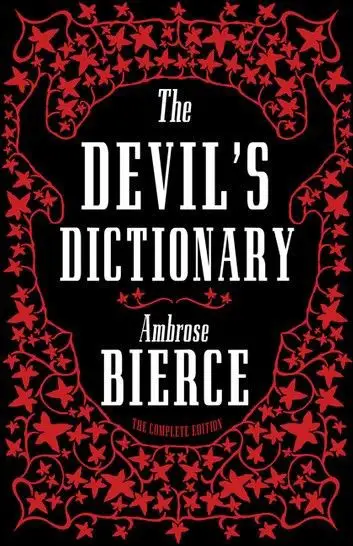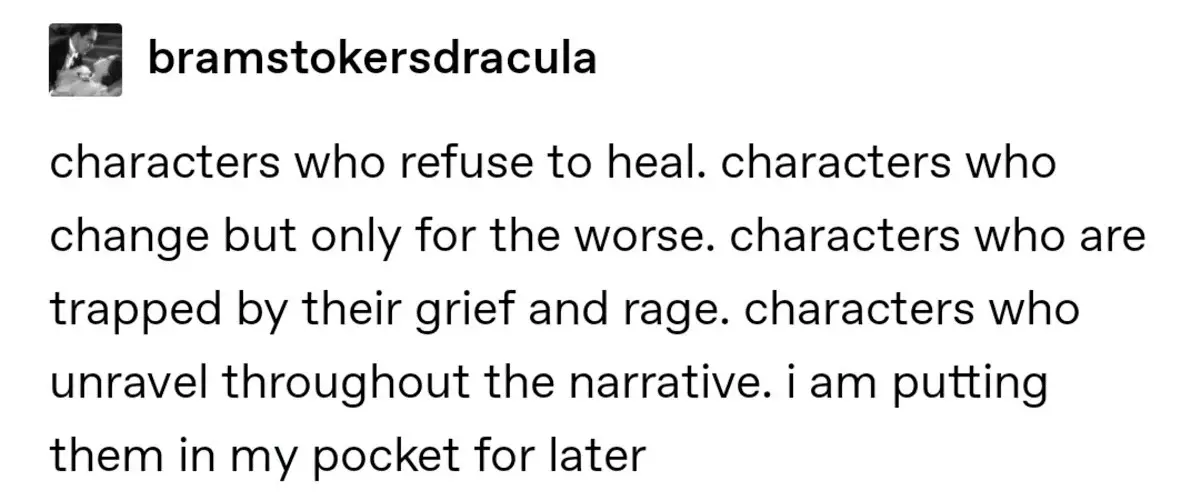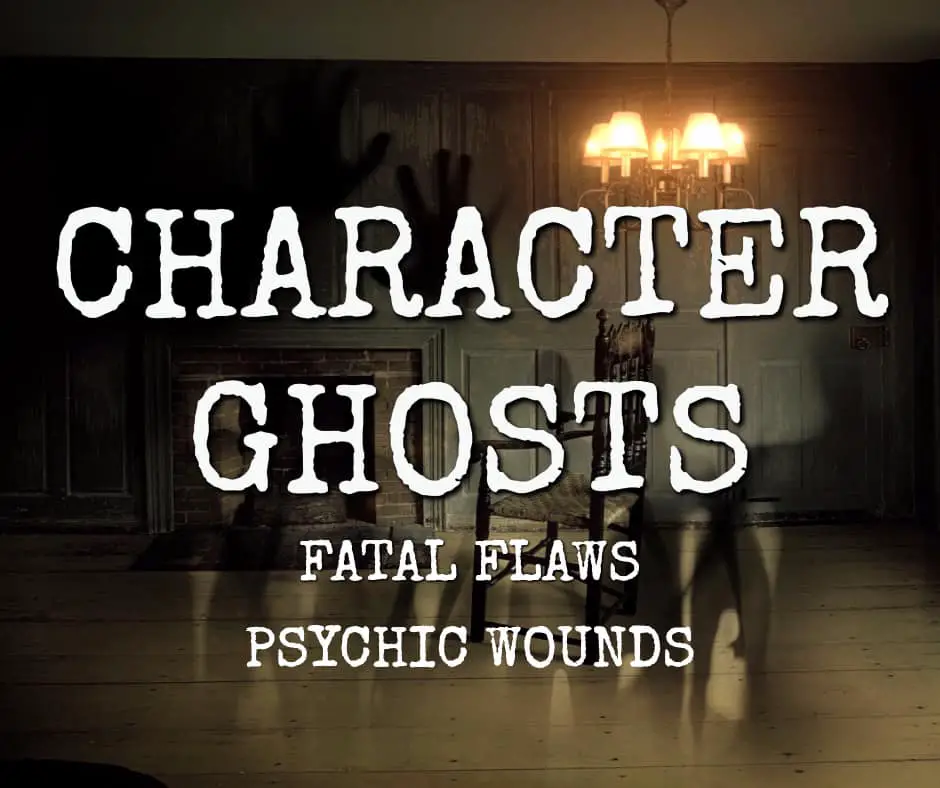There are various words to describe the event from a main character’s past which holds them back in the present: the fatal flaw, the psychic wound, the ghost.
“Our culture believes strong individuals can transcend their circumstances. I myself don’t much enjoy books by Hardy or Dreiser or Wharton, where the outside world is so strong, so overwhelming, that the individual hasn’t a chance. I get impatient, I keep feeling that somehow the deck is stacked unfairly. That is the point, of course, but my feeling is that if that’s true, I don’t want to play. I prefer to move to another table where I can retain my illusion, if illusion it be, that I’m working only against only probabilities, and have a chance to win. Then if you lose, you can blame it on your own poor playing. That is called a tragic flaw, and like guilt, it’s very comforting. You can go on believing that there really is a right way, and you just didn’t find it.”
Marilyn French
The word ‘ghost’ may come from Ambrose Bierce:
Ghost: The outward and visible sign of an inward fear.
Ambrose Bierce, The Devil’s Dictionary

I’ve even heard the word ‘scars’.
A character becomes their scars. That’s not to say they’re defined by them, but their responses to them are.
@SamSykesSwears
Fatal flaws aren’t always fatal and suggest they tend to be inborn. Fatal flaw refers to what I prefer to call the psychological shortcoming, and the ghost is a bit different.
‘Psychic wound’ is good, but other people use the word ‘ghost’. (e.g. Karl Iglesias) This is even better because I can visualise this thing as an alter-character following the main character around, actively getting in the way of their goals. However, ghosts refer to supernatural creatures, so let’s stick with ‘psychic wound’.
Most often, the Ghost involves traumas such as abandonment, betrayal, or a tragic accident which leaves the character permanently injured or disfigured, or causes guilt if the character feels he has caused another’s death. It can also be the death of a loved one. Basically, any traumatic incident that created a sense of loss, or a psychological emotional wound. […] The difference between Backstory and Ghost is that the first molds the character’s personalty, whereas the latter is still an open wound which haunts the character in your story and affects his inner need. Both, if interesting, can add emotional complexity and fascination to your character.
Writing for Emotional Impact by Karl Iglesias
Notice Iglesias mentions injuries and disfigurements. A disfigured character is a trope of yore, and modern writers need to be careful about that one. In these more enlightened times we know that a disfigurement or injury or missing right hand does not actually say anything about that person at all, but earlier stories conflated physical wounds with evil and mal-intent.
MOST COMMON TYPE OF PSYCHIC WOUND
The ghost itself acts as one of your main character’s opponents. One of. It’s rarely enough in a story to make your main character their ‘own worst enemy’. The ghost will be an add-on to your opposition — not the main bread and butter. (Unless you’re writing an experimental short story.)
THE FATAL FLAW
The most devastating ghost or psychic wound is sometimes called a fatal flaw.
In The Secret History, Donna Tartt opens Chapter One with the following paragraph:
Does such a thing as ‘the fatal flaw,’ that showy dark crack running down the middle of a life, exist outside literature? I ued to think it didn’t. Now I think it does. And I think that mine is this: a morbid longing for the picturesque at all costs.
Donna Tartt
The concept ‘fatal flaw’ is clearly well-known, in everyday language as well as among storytellers, or Tartt’s metafictive opening wouldn’t work.

DO CHILD CHARACTERS NEED PSYCHIC WOUNDS?
What if your character is very young? A toddler in a picture book probably doesn’t have a psychic wound. They haven’t lived long enough. And if they are already damaged individuals, you’re probably not writing a children’s book. In a carnivalesque story they definitely won’t be damanged, because a carnivalesque story is all about having fun — for both the character and the reader.
Even a middle grade kid who has made it all the way through primary school doesn’t necessarily have a psychic wound. A lot of middle grade characters are a stand-in for The Every Child, where plot is given preference.
PSYCHIC WOUNDS AND UTOPIAN SETTINGS
Less common is the story in which a ghost is not possible because the hero lives in a paradise world. Instead of starting the story in slavery — in part because of his ghost — the hero begins free. But an attack will soon change all that.
This second type of ghost is far more common in children’s literature than in adult film. This makes sense, since children’s literature is where you will find many more genuine utopias (well, up until middle grade).
What about the first category, though? Do kids ever have ghosts/psychic wounds in books starring kids, for kids?
CHILDREN WHO DO HAVE PSYCHIC WOUNDS
Being an orphan is a pretty popular psychic wound for children, and there are many, many orphans in children’s literature. For the writer, this gets the parents right out of the way so children can have their independent adventures but it works doubly to create a psychic wound. The great thing about orphans is, even for child readers who are not themselves orphans, the fear of becoming an orphan is ever-present.
PARENTS WHO TRANSFER THEIR OWN PSYCHIC WOUNDS
Oftentimes the parent is the one with the ghost. This ghost affects the child, because the child is completely under the control of the adult.
Perhaps the child isn’t an orphan but has lost someone close — commonly a grandparent. Lyndsey’s character arc is set off in Freaks and Geeks after the death of her beloved grandmother, when she decides things are going to have to change around here. Suddenly aware of her own mortality, she seems to realise she can’t lead her one and only best life if she lives it like her own parents are.
In middle grade and above, rejection might take another form as the main character realises they don’t have the friends they want. Peer rejection.
This moves into possible romantic rejection in young adult literature, though the main character usually finds someone by the end, following ‘a Jack for every Jill’ ideology.
One thing is clear: fear of abandonment and rejection crops up time and again in children’s stories. This is no doubt connected to the fact that children are developmentally unable to care for themselves. Without adults in their lives, they would not survive.
Fear of abandonment morphs into fear of romantic/professional/social rejection in stories for adults. This, alone, is not a ghost but a psychological shortcoming, but once the audience is told that the main character has suffered from actual abandonment in the past, this is a ghost.
In one aspect, yes, I believe in ghosts, but we create them. We haunt ourselves.
Laurie Halse Anderson
HOW TO WRITE A CHARACTER GHOST
The ghost is connected to the main character’s psychological shortcoming and desire, so get that out of the way first.
WITHHOLD DETAILS
Most writers don’t let the audience in on the ghost right away. They keep it as one of their plot revelations.
That said, occasionally the ghost appears in the first few scenes. Ghosts don’t have to be used as plot reveals. They can be introduced early as points of interest.
HOW TO REVEAL CHARACTER GHOST
Commonly in film: another character explains the hero’s ghost somewhere in the first third of the story. If writing cinematically, novelists may choose to do this also, but we don’t have to. The narrator can reveal the backstory of the ghost in the narrative summaries without it having to come via dialogue.
IRONIC BACKSTORY
There is a case to be made for keeping backstory right out of any story unless it is ironic backstory. In other words, leave out the backstory the audience could have guessed anyway. If your main character is a 9-year-old boy who lives in the middle class suburbs of midwestern America we don’t need to be told about how he started elementary school when he was five, likes to watch Pixar movies and loves to eat pie. This boy’s backstory becomes ironic if you tell us his family used to live in their car, won the lottery and moved to this suburb last year.
Does advice to avoid non-ironic backstory apply equally to this specific type of backstory — the fatal flaw? I’ll argue no.
Case in point: sometimes we’re given the backstory of a villain which explains why they’ve ended up so villainous. If a villain became a villain because they were mistreated in the past this isn’t ironic — it is fully expected. However, the story of the fatal flaw must be inherently interesting and, if introduced at all, will probably have its own fully-formed story attached. (Some might call this a subplot.)
Note that a fully-formed story does not have to be lengthy. A 20 second TV commercial will be a fully-formed story.
COMMON TROPES RELATED TO THE PSYCHIC WOUND
Some of these tropes work well time and again — others you might avoid for ethical/overdone reasons.
In crime fiction, time and again we find the alcohol/tobacco addicted, workaholic, mechanically driven cop who is bad with people but can somehow read people well enough to apply their knowledge in their detective work. Most lately we have a number of autistic savants, or characters who tend to be read that way by an audience who know that one variation of autism (without the other bits which make up an entire individual).
In some romance imprints there are a lot of laconic men who are nevertheless good in bed because they absorb what their partners want by osmosis, or by relying on some kind of naked animal instinct. In supernatural romance, sometimes these men really are actual beasts of some kind. He may have been hurt by women in the past, or let down. Finally, in this story, he meets a woman who is not like all the others. Works as a fantasy; not good if applied to real life.
Mothers in horrors are almost always ‘fatally flawed’. Hana Shafi explains why this is a problem:
Marge [Nightmare On Elm Street] and her alcoholism, Wendy [The Shining] and her nervous passiveness, Maureen [Scream] and her infidelity. For centuries, real-life mothers have been blamed for social ills, both perceived and real. Mothers who work are neglecting their families; mothers who don’t work aren’t contributing to society or progressing the women’s movement; mothers who try to do it all are just kidding themselves. We plaster celebrity mothers on the covers of magazine and put them on informal trials: Are they good mothers or bad mothers? Are they worthy mothers? Are they capable of protecting their child? Will they make the right sacrifices, and often?
If horror movies are warnings, then they also act as our prescriptive fantasies for what happens if you’re a “bad” mother, if you don’t pay attention to what your kid is doing, if you opt out of the nuclear family dynamic. They say: be better or, essentially, be punished. Horror movie audiences are encouraged to feel critical of mothers. We might ask, “Will the monster win?” but it often feels like the true questions in horror are the same ones we ask of celebrity mothers, and of mothers everywhere: Are they good enough? Is everything bad that happens to the child the mother’s fault? Just as in real life, it seems, mothers are held responsible for anything and everything, no matter what they do.
The Walrus
RELATED CONCEPT: THE SOUL TOUPEE
This is a concept invented by writer/cartoonist Tim Kreider and his friend. He writes about this in his essay “The Csar’s Daughter” in the collection We Learn Nothing. This essay is a wonderful example of a character sketch — a ‘fabulist’ (liar) friend who leads Kreider into a profound series of insights into why people lie and how others are complicit.
Here, he explains the Soul Toupee, which I feel is related to the Ghost:
Years ago a friend of mine and i used to frequent a market in Baltimore where we would eat oysters and drink Very Large Beers from 32-ounce Styrofoam cups. One of the regulars there had the worst toupee in the world, a comical little wig taped in place on the top of his head. Looking at this man and drinking our VLBs, we developed the concept of the Soul Toupee. Each of us has a Soul Toupee. The Soul Toupee is that thing about ourselves we are most deeply embarrassed by and like to think we have cunningly concealed from the world, but which is, in fact, pitifully obvious to everybody who knows us. Contemplating one’s own Soul Toupee is not an exercise for the fainthearted. Most of the time other people don’t even get why our Soul Toupee is any big deal or a cause of such evident deep shame to us but they can tell that it is because of our inept, transparent efforts to cover it up, which only call more attention to it and to our self-consciousness about it, and so they gently pretend not to notice it. Meanwhile we’re standing there with our little rigid spongelike square of hair pasted on our heads thinking: Hey—got ’em all fooled!
Tim Kreider
This concept is so useful for writers because it links two vital aspects of characterisation:
- The Ghost
- The Mask, which I have written about elsewhere.
FURTHER READING
Brainstorming Your Character’s Emotional Wound by Angela Ackerman
How to Write Essential Backstory Elements from Stavros Halvatzis
Fiction’s Wounding Event: Where Character and Incident Meet by Michelle Hoover

